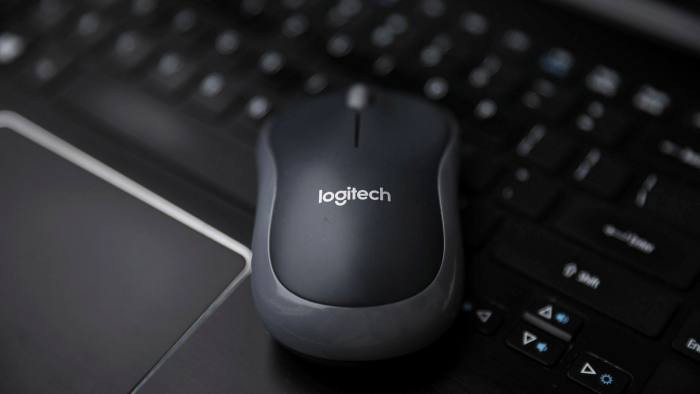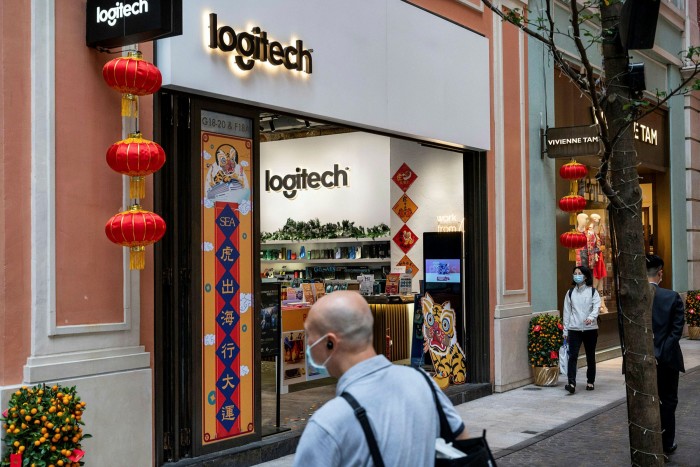
Tech manufacturers wrestle with supply chain emissions
 Click click hurray: Switzerland-based Logitech tops this year’s Europe’s Climate Leaders list © Agron Beqiri/PA
Click click hurray: Switzerland-based Logitech tops this year’s Europe’s Climate Leaders list © Agron Beqiri/PA Get the latest news and comment on the most pressing issues in the technology sector with our #techFT bulletin. Delivered every weekday.
Earbuds, keyboards and computer mice are plastic, often cheap, and easy to lose or discard.
Many of these computer peripherals gather dust in desk drawers and end up in landfill. In fact, electronic waste — anything with a plug or battery — is now the world’s fastest-growing type of domestic refuse, according to the UN. It forecasts that, by 2030, the world will produce 74mn tonnes of e-waste a year.
So it may be a surprise that a computer peripherals manufacturer — Switzerland-based Logitech — is top of this year’s FT-Statista list of Europe’s Climate Leaders.
Of the thousands of companies surveyed, it was the one that cut its Scope 1 and Scope 2 greenhouse gas (GHG) emissions intensity the most — 47 per cent year on year — between 2015 and 2020.
Large reductions in Scope 1 and 2 emissions intensity need to be put in context, though. Scope 1 and 2 emissions come, respectively, from a company’s own operations and from the energy it uses. Intensity is defined as tonnes of emissions of CO2-equivalent per €1mn of revenue. Reductions can therefore be achieved by buying renewable energy to power factories and using more recycled plastic in products.
 High-tech landfill: the UN predicts that global e-waste will reach 74mn tonnes a year by 2030 © Alamy
High-tech landfill: the UN predicts that global e-waste will reach 74mn tonnes a year by 2030 © Alamy And, for computer peripherals companies, Scope 1 and 2 emissions are less than 10 per cent of their total carbon footprint says Syed Yaqzan, who teaches at Cranfield School of Management and advises businesses on energy efficiency.
It is Scope 3 emissions, which arise along the value chain — including from suppliers providing parts and customers using products — that cause the most environmental harm.
In the case of Logitech, these Scope 3 GHGs account for 99.8 per cent of the total, because Scope 1 and Scope 2 emissions have been reduced to “negligible” levels, the company says.
More stories from this reportEurope’s Climate Leaders 2022: interactive listing
ISSB sets out to tighten up climate reporting
Carmakers embrace greener vision in wake of Dieselgate
Race to cut carbon emissions fuels climate tech boom
New SBTi boss takes over as criticisms mount
The carbon offset market is falling short. Here’s how to fix it
Industrial strength amplifies Germany’s carbon challenge
However, not all peripherals companies even measure their emissions, let alone have targets to cut them, experts note.
“Emissions are getting outsourced to the supply chain,” says Dexter Galvin, global director of corporations and supply chains at CDP, a global not-for-profit that helps organisations manage their environmental impact.
Cutting Scope 3 emissions can be hard for peripherals companies, especially smaller ones, because they do not have direct control over their supply chain, Galvin adds.
Large companies, by contrast, can use buying power to cajole their main suppliers — which may number several hundred — to cut their emissions and encourage their own suppliers to do the same.
Overall, though, the sector is doing better at cutting emissions than many other industries, experts say. But there is plenty of room for improvement, including in making products that last longer.
Extending the average lifetime of a product from three to five years would have a “colossal impact on the carbon footprint of the device”, says Ben Stanton, a research manager for technology, media and telecommunications at consultancy Deloitte UK.
Recommended Special ReportManaging Climate ChangeComplexity of supply chain emissions forces rivals to work together on net zero
Logitech says it aims to reduce Scope 3 emissions by at least 50 per cent by 2030, compared with its 2019 levels.
Its Scope 1 and 2 emissions have gone down through switching to renewable sources of energy, such as solar and wind power — to the extent that 92 per cent of the company’s energy worldwide is from renewables. Logitech hopes to reach 100 per cent by 2030.
It has also built a portal for its suppliers so that they can bulk-buy certified renewable electricity for their factories.
Larger suppliers typically have well-established policies on environmental, social and governance (ESG) matters says Prakash Arunkundrum, Logitech’s head of global operations and sustainability. “For smaller suppliers . . . we have had to use more cajoling . . . It’s not a question of motivation, it’s a question of [suppliers] understanding [their emissions] data.”
Logitech’s other plans to cut Scope 3 emissions include making products last longer by refurbishing and reselling them, and using more low-carbon materials.
 Logitech has slashed its Scope 1 and 2 emissions — but nearly all of its carbon footprint is Scope 3 © Budrul Chukrut/Alamy
Logitech has slashed its Scope 1 and 2 emissions — but nearly all of its carbon footprint is Scope 3 © Budrul Chukrut/AlamyIn the longer-term, materials derived from biological sources such as mushrooms and hemp could be used in the “next frontier” of electronics products, Arunkundrum adds.
Technology can help companies measure and shrink their carbon footprints, too.
Lenovo — another computer and peripherals maker in this year’s list — uses an online platform to calculate its products’ environmental impact.
This tool — developed by sustainability consultancy Quantis and the Massachusetts Institute of Technology — “makes assumptions about how a product is built, [its] screen size and memory”, says Mary Jacques, Lenovo’s director of global environmental affairs and sustainability. “It will give a number for how much carbon a product will produce in manufacture, [consumer] use and disposal.”
Alongside voluntary good practice, environmental regulations are being tightened.
The European Commission has updated its energy label requirement for electronic products and has proposed minimum efficiency requirements for IT equipment.
The EU’s Waste from Electrical and Electronic Equipment directive stipulates that 75 per cent of small IT equipment should be recovered by the maker and 55 per cent should be prepared for reuse and recycling, explains a Commission official at the environment department.
Every business in the sector needs to . . . demand change from their partners
Dexter Galvin, CDPAlthough Logitech is headquartered in Switzerland, which is not an EU member, the company complies with all EU regulations because its products pass through EU countries — and “as a matter of best practice”.
According to the Commission official, it is estimated that less than 40 per cent of e-waste in the EU is recycled. She adds that the Commission is considering further incentives for manufacturers to take back equipment and for consumers to return it.
Emissions are an industry-wide problem. If all companies in the global peripherals sector tackle their Scope 1 and Scope 2 emissions, then Scope 3 emissions will necessarily plummet, says Galvin.
“Every business in the peripherals sector needs to take a hard look at where these emissions are coming from and demand change from their partners,” he adds. “Every board should have a serious plan for tackling these emissions or they aren’t doing their job properly.”
{"focus":["0b57a96f-e776-40d8-bbc3-7a248886bee7","24ad2c58-14fb-4217-b6f7-7ef88ac51375","59d55e5c-cb83-49dc-bacb-26dcc51566d0","6b32f2c1-da43-4e19-80b9-8aef4ab640d7","7dc8fe26-965c-465b-8a4d-1f1941021baa","ff7a5067-f9d9-4b39-87cb-501b27ba5e85","06610896-2754-4847-a48f-9363d18a8c5e","29e67a92-a3b8-410c-9139-15abe9b47e12","2e7429bd-7a84-41cb-a619-2c702893e359","82645c31-4426-4ef5-99c9-9df6e0940c00","c47f4dfc-6879-4e95-accf-ca8cbe6a1f69","e58e66fe-7cc6-4382-b781-1161bae8b905","ec4ffdac-4f55-4b7a-b529-7d1e3e9f150c"],"authorConcepts":["885c60f9-58be-499c-9d3b-2239f318ba0f"],"displayConcept":"6b32f2c1-da43-4e19-80b9-8aef4ab640d7"}Get alerts on Technology sector when a new story is published
Get alertsCopyright The Financial Times Limited 2022. All rights reserved.Reuse this content (opens in new window) CommentsJump to comments sectionPromoted ContentExplore the Special ReportREAD MOREEurope’s Climate LeadersTech manufacturers wrestle with supply chain emissionsnew
- Currently reading:Tech manufacturers wrestle with supply chain emissions
- New SBTi boss takes over as criticisms mount
- The carbon offset market is falling short. Here’s how to fix it
- Carmakers embrace greener vision in wake of Dieselgate
- ISSB sets out to tighten up climate reporting
- Race to cut carbon emissions fuels climate tech boom
- Industrial strength amplifies Germany’s carbon challenge
- Sustainability Add to myFT
- Climate change Add to myFT
- Supply chains Add to myFT
- Technology sector Add to myFT
- Emission standards Add to myFT
Owl Media Group takes pride in providing social-first platforms which equally benefit and facilitate engagement between businesses and consumers and creating much-needed balance to make conducting business, easier, safer, faster and better. The vision behind every platform in the Owl Media suite is to make lives better and foster a healthy environment in which parties can conduct business efficiently. Facilitating free and fair business relationships is crucial for any thriving economy and Owl Media bridges the gap and open doors for transparent and successful transacting. No advertising funds influence the functionality of our media platforms because we value authenticity and never compromise on quality no matter how lucrative the offers from advertisers may seem.
Originally posted on: https://www.ft.com/content/61b17e12-165b-43fb-959b-74da1fd45ac9